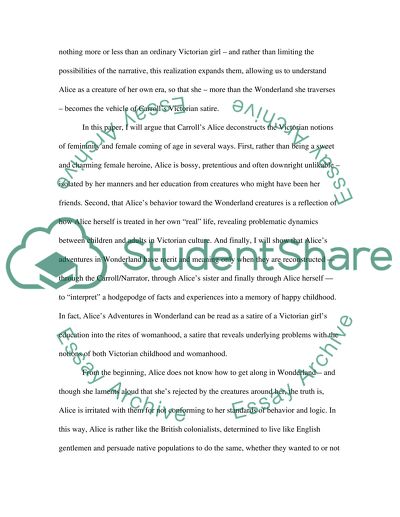Cite this document
(How Carroll's Alice Deconstructs the Victorian Notions of Femininity Case Study, n.d.)
How Carroll's Alice Deconstructs the Victorian Notions of Femininity Case Study. Retrieved from https://studentshare.org/gender-sexual-studies/1565308-examine-how-alices-adventures-in-wonderland-major-theme-of-growing-up-and-finding-ones-identity-are-a-reflection-and-product-of-a-victorian-age-and-how-wonderland-is-a-social-satire-of-victorian-culture
How Carroll's Alice Deconstructs the Victorian Notions of Femininity Case Study. Retrieved from https://studentshare.org/gender-sexual-studies/1565308-examine-how-alices-adventures-in-wonderland-major-theme-of-growing-up-and-finding-ones-identity-are-a-reflection-and-product-of-a-victorian-age-and-how-wonderland-is-a-social-satire-of-victorian-culture
(How Carroll'S Alice Deconstructs the Victorian Notions of Femininity Case Study)
How Carroll'S Alice Deconstructs the Victorian Notions of Femininity Case Study. https://studentshare.org/gender-sexual-studies/1565308-examine-how-alices-adventures-in-wonderland-major-theme-of-growing-up-and-finding-ones-identity-are-a-reflection-and-product-of-a-victorian-age-and-how-wonderland-is-a-social-satire-of-victorian-culture.
How Carroll'S Alice Deconstructs the Victorian Notions of Femininity Case Study. https://studentshare.org/gender-sexual-studies/1565308-examine-how-alices-adventures-in-wonderland-major-theme-of-growing-up-and-finding-ones-identity-are-a-reflection-and-product-of-a-victorian-age-and-how-wonderland-is-a-social-satire-of-victorian-culture.
“How Carroll'S Alice Deconstructs the Victorian Notions of Femininity Case Study”. https://studentshare.org/gender-sexual-studies/1565308-examine-how-alices-adventures-in-wonderland-major-theme-of-growing-up-and-finding-ones-identity-are-a-reflection-and-product-of-a-victorian-age-and-how-wonderland-is-a-social-satire-of-victorian-culture.


